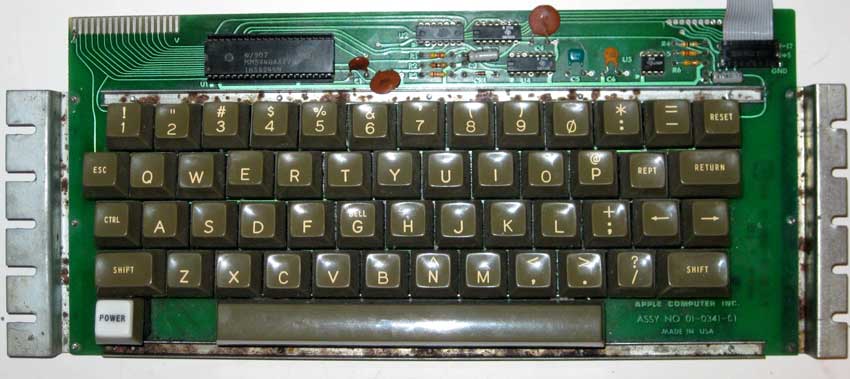So, this all started on the Apple II, the first Apple product to actually come with a keyboard:

That's 13.5 U wide. It's based on earlier Datanetics keyboards (what was typically recommended for the Apple-1), which were based on the ASR-33.
The Apple /// changed things up to a 14.5 U layout (ignoring the numpad). Note that the 15 U layout was very much not standardized by that point, it was the Model F that would really do that. The closest thing to a standard was the Selectric III, and that had just come out, so Apple wasn't following that standard yet. (The 92-character Selectric III is ultimately what the 101-key Model M would be based on.) I think this was the only layout that could truly be called Apple's own, not inspired by any IBM or Teletype products (although the layout of the special characters on the number row already has gone to the US Selectric configuration, instead of the ASCII configuration):

The Apple //e fixed some serious deficiencies in that layout, and started adopting design characteristics of the Selectric III (the /// Plus and the //c would go on to use variants of this layout - so, the reason that layout did 14.5 U is because the /// did 14.5 U and they needed to share the design):

And, here's where they got into ISO (later revision of the keyboard, but same layout), and where .75 U-wide keys became a thing:

Now, this doesn't explain the Lisa or original Mac keyboards (same layout, Lisa got a numpad, 14.5 U) other than just wanting to be compact and 14.5 U being Apple's thing. The Mac keyboard being 14.5 U explains the Mac Plus keyboard being 14.5 U, and the fact that they never intended arrow keys for it explains why they were bodged in so hackishly. And, the PC AT was a big deal when the Mac Plus keyboard came out, hence the (skinnier due to being 14.5 U) big-ass Enter on the Mac Plus.
But, it can explain the IIGS keyboard, which was mechanically shared with the Platinum IIe (which, even with a 14.5 U typing area, was very tight in that chassis due to the numpad), the IIc Plus (where 14.5 U was absolutely necessary), and eventually a Mac keyboard. And, those boards also did the big-ass Enter on a diet thing.
Anyway, the Apple Extended Keyboard is where things changed to 15 U. Really, that thing was Apple grudgingly admitting that they had customers that wanted a keyboard that looked like an IBM keyboard, even though their platforms had no use for it at the time. However, I don't actually see an ISO variant! I found an AZERTY ANSI variant, which must have been incredibly strange. (And they had no qualms about doing AZERTY in ISO for the Apple II and for smaller keyboards.)
There's also the Apple Keyboard II from 1990, which is
14.75 U 15 U but shifted over by .25 7 on ANSI, but no ISO variant there either.
The Apple Extended Keyboard II is where offsetting ISO variants .25 U to the right started, it seems. I'm not sure why they did it, it may be that they expected users to be used to the right side of their 14.5 U ISO keyboards (which was everything they made ISO-wise from 1983 until 1990, including Lisas, Macs and Apple IIs, and I believe every laptop they ever made except for the eMate (which is just oddball and has miniaturized keys anyway) - and they were inconsistent on arrow keys on laptops (ANSI got a horizontal cluster, ISO got an L-shaped cluster like the Mac Plus) until the PowerBook G3 (which switched to half-height inverted T)), rather than the left side. So, they added a quarter unit to both sides to keep everything "centered" in the perspective of an ISO user, I think.
Now, it seems Apple wasn't actually consistent here. The Pro Keyboard, the USB Keyboard
actually went to 14.75 U (taking the units out of the right on ANSI, the left on ISO), then Apple switched back to 15 U, and the Apple Keyboard A1048 weren't shifted over for their ISO variants it seems.
Then, the aluminum keyboards brought 14.5 U back to the desktop.
So, basically, you can blame the Apple /// (which required Apple to stick with 14.5 U for their Selectric III-inspired layouts) for Apple having oddball layouts today.



